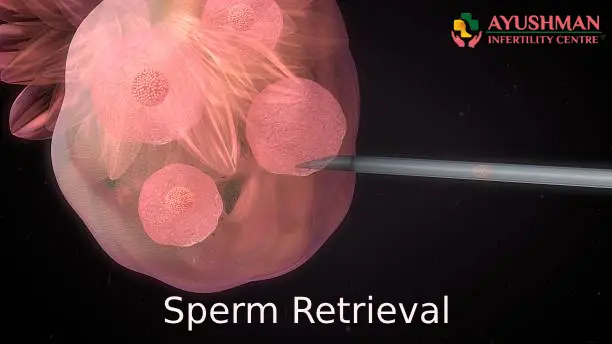
Why and When is Sperm Retrieval Done?
Sperm retrieval is recommended when a couple is trying to achieve pregnancy but faces challenges due to low or absent sperm in the semen, or if a man is unable to ejaculate. In such situations, sperm can be obtained from other parts of the reproductive system. This procedure is often paired with in vitro fertilization (IVF) or intracytoplasmic sperm injection (ICSI) to enhance the chances of successful pregnancy.
In vitro fertilization (IVF) involves combining an egg and sperm in a lab dish to form an embryo, which is then transferred to the uterus for development. Intracytoplasmic sperm injection (ICSI) is a specific type of IVF where a single sperm is directly injected into an egg.
To determine sperm presence in the semen, a semen analysis is conducted by examining the sample under a microscope. If no sperm is found (azoospermia), it may prompt the need for sperm retrieval.
There are two main types of azoospermia:
Obstructive Azoospermia:
- Sperm production occurs, but a block in the male reproductive tract prevents them from reaching the semen.
- Examples include a vasectomy (surgery to block sperm) or defects in the vas deferens, epididymis, or ejaculatory duct.
- Surgical correction is possible in some cases.
Non-obstructive Azoospermia:
- The body may produce little to no sperm, or the sperm levels are too low to appear in ejaculate.
- Blood hormone and genetic tests help identify the cause.
- Conditions like anejaculation (lack of ejaculation) or retrograde ejaculation (semen flowing back into the bladder) may contribute to the absence of visible semen.
- Causes include spinal cord injuries, advanced diabetes, multiple sclerosis, psychological issues, and pelvic surgery.
Diagnosis of these conditions involves checking the urine for sperm after an orgasm. If natural sperm release is not possible, sperm retrieval may be recommended as a solution.
Treatment Options for Sperm Retrieval
If you’re experiencing anejaculation or retrograde ejaculation, where natural ejaculation is challenging, non-surgical sperm retrieval methods can be considered. Here are two methods:
Penile Vibratory Stimulation (PVS):
- PVS involves using a special vibrator placed at the tip of the penis to induce ejaculation.
- This method can be effective in triggering ejaculation.
Electroejaculation (EEJ):
- EEJ uses a probe that sends electrical energy to the prostate and seminal vesicle.
- It may be performed in the urologist’s office for men with nerve injuries and no sensation.
- For men with normal sensations, general anesthesia is required to prevent pain during the procedure.
In cases where PVS or EEJ is unsuccessful, other methods may be needed for sperm retrieval from the epididymis or testicle. Some of these procedures include:
Testicular Sperm Extraction (TESE):
- TESE is commonly used to diagnose the cause of azoospermia and extract sperm tissue.
- It can be performed in the urologist’s office with a nerve block or under anesthesia in a surgical center.
- One or several small cuts may be made in the testes.
Testicular Sperm Aspiration (TESA):
- TESA, or Testicular Fine Needle Aspiration, is a procedure using a thin needle to collect sperm from the testicles.
- It can be done with a nerve block in the urologist’s office or the operating room, without the need for additional cuts.
TESA with Mapping:
- This involves multiple needle aspirations throughout the testes and is used for non-obstructive azoospermia.
- It is considered comparable to TESE at recovering sperm.
Microsurgical Epididymal Sperm Aspiration (MESA):
- MESA uses a surgical microscope to retrieve sperm from the epididymis tubes.
- It can retrieve a significant amount of healthy sperm, which can be saved and frozen for later use.
- General anesthesia and a highly skilled micro-surgeon are involved in this safe procedure.
Percutaneous Epididymal Sperm Aspiration (PESA):
PESA is a cost-effective option, especially for obstructive azoospermia.
It can be done under local or general anesthesia, involving a needle attached to a syringe to gently remove fluid from the epididymis.
Microsurgical Testicular Sperm Extraction (Micro-TESE):
- Micro-TESE is specifically for non-obstructive azoospermia, conducted by a urologist trained in microsurgery.
- It is typically performed in the operating room, allowing for a more thorough examination of the testis with minimal tissue removal and less damage to blood vessels.
- Some experts believe that Micro-TESE improves the chances of finding sperm in patients with non-obstructive azoospermia.
Post-Treatment Recovery
The recovery period after testicular or epididymal sperm retrieval varies based on the chosen method, typically lasting from a few days to a week. Here’s what to expect:
Activity and Support:
- Most men are advised to avoid strenuous activities during the initial recovery phase.
- Wearing a jockstrap may be recommended until full recovery is achieved.
- Ice packs can be applied immediately after the procedure to reduce swelling.
Medication:
- Your urologist will prescribe pain medication to manage any discomfort.
- Antibiotics may also be given before and/or after sperm retrieval to minimize the risk of infection.
Healing Time:
- If stitches are involved, additional time may be needed for proper healing.
- Returning to office work is usually possible within 24 to 48 hours.
- Engaging in heavy work may require 5 to 10 days of recovery.
Possible issues during recovery include:
- Bleeding: Some bleeding may occur, but it is usually minimal.
- Infection: Antibiotics are prescribed to minimize the risk of infection.
- Pain: Pain management medication is provided to alleviate discomfort.
- Failure to Find Sperm: There is a chance that sperm may not be found during retrieval.
- Future Procedures: Depending on the outcome, additional procedures may be necessary.
- Testicular Injury or Loss: Although rare, there is a slight risk of testicular injury or loss.
Following post-treatment guidelines and promptly reporting any concerns to your healthcare provider ensures a smoother recovery process.
Leave a reply
Leave a reply